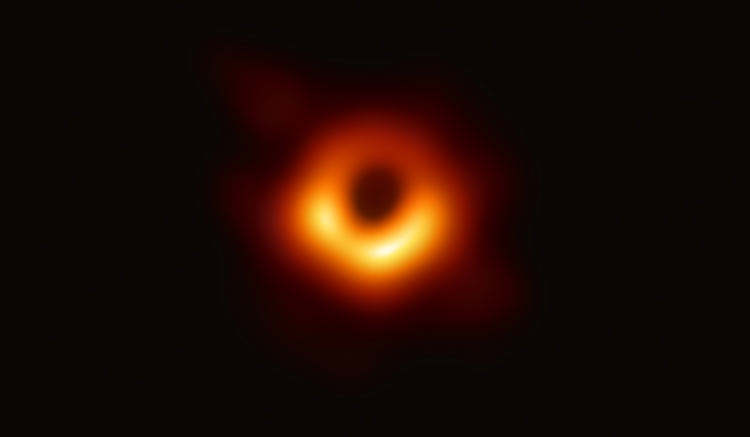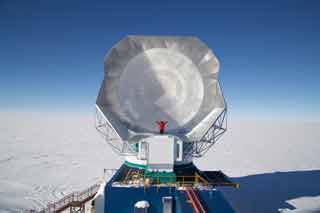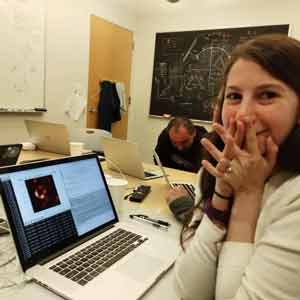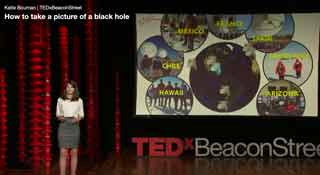Historic Photograph of a Black Hole
 Above, a "photograph" of a black hole, created from an earth-sized "camera" consisting of 8 observatories at 6 sites. The above image was released on 10 April 2019 by the Event Horizon Telescope (EHT) consortium in press conferences in Washington, DC (as well as in six other nations--Belgium, Denmark, Chile, Japan, China and Taiwan). The original data was collected by the various EHT observatories on four days in April--the 5th, 6th, 10th, and 11th; actually a different image was produced for each day of observation. The one shown above, from the 11th, is considered a representative sample. This page from the EHT website identifies the eight sites (including Pole) that were involved in the black hole observations, as well as later/future EHT sites (surprisingly including the Greenland Telescope which I've been following for awhile--it's currently located at Thule Air Base and may yet end up at Summit someday). The data principle used was very long baseline interferometry (VLBI)--using distant radio telescopes to create a single virtual telescope (in other words, to create a telescope "lens" the diameter of Earth). The black hole is located in the supergiant elliptical galaxy Messier 87 (M87) in the constellation Virgo, about 54 million light-years from Earth (M87 images and more information from NASA's Chandra X-Ray Observatory satellite telescope). Actually, the SPT, unlike the other EHT sites, was not in a position to directly observe the black hole, but it participated in observations of 3C 279, a variable quasar also in the Virgo constellation--3C 279 was used as a calibrator source for the M87 black hole observations.
At Pole, the observation effort involved 10 18-hour days in a row for the two 2017 SPT winterovers Andrew Nadolski and Daniel Michalik. DSL where SPT is located was darkened, and movements inside the building were muted to prevent disturbing the precise hydrogen maser atomic clocks which synchronized the SPT's EHT receiver with the rest of the global network. The data collected at all sites ran to about 5 million gigabytes...which was way too much to be transmitted over the internet. Hence, the hard drives from Pole had to be flown north at the end of the winter, and defrosted at the two major analysis sites--MIT's Haystack Observatory and the Max Planck Institute for Radio Astronomy in Bonn, Germany. Four subgroups at four different laboratories around the world were assigned to develop the image--the teams worked in secret from each other as a form of quality control. The final image was a result of collaborative evaluation of the many images obtained from the four groups based on the four days of observation. The image as well as the background of its creation was announced in this 10 April 2019 press release...as well as in coordinated press conferences around the world. The NSF press conference is documented here with video and a transcript, and a more detailed media resource page was provided here; it includes a number of background videos and fact sheets about the black hole image project, the EHT, and the black hole image at the top of this page. The NSF press release also provided links to six papers, published the same day (and open access) in the Astrophysical Journal Letters. These give all of the details of the black hole image capture and documentation:
Among the 300-plus researchers who contributed to the project, one person--Katie Bouman at the Haystack Observatory has received a significant amount of media attention for leading the creation and development of the algorithm used to produce the black hole image. One bit of that attention is this BBC News article "Katie Bouman: The woman behind the first black hole image," which includes her viral Facebook photo post (left) which she captioned: "Watching in disbelief as the first image I ever made of a black hole was in the process of being reconstructed." Also relevant, particularly from a South Pole point of view, is this Washington Post article "Scientists reveal the first image of a supermassive black hole" which quotes Jessica Dempsey, deputy director of the James Clerk Maxwell Telescope on Mauna Kea, Hawaii, as saying that the image reminded her of the flaming Eye of Sauron from the Lord of the Rings trilogy. Jessica wintered at Pole with me in 2005 when she was monitoring the Viper telescope. 2023 update--this 13 April Letter in The Astrophysical Journal Letters describes and depicts and depicts the black hole differently using PRIMO technology, which improves the ability to measure the mass and other physics of the black hole. This 13 April 2023 Washington Post article explains things. Also I must credit and thank 2017 winterover Grant Hall for interesting me in the South Pole aspects of this story and providing some of the background info. Grant was operating the BICEP3 telescope which was located at the other end of DSL from the SPT, so he was very close to what was going on. | ||


